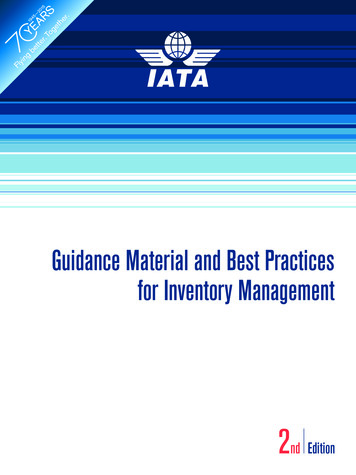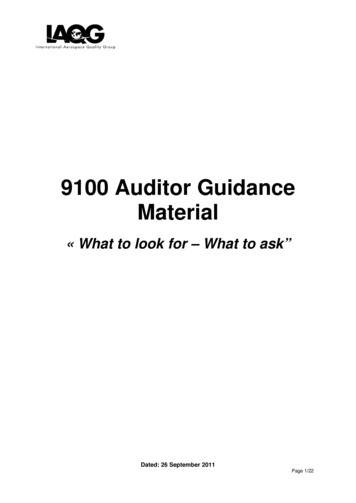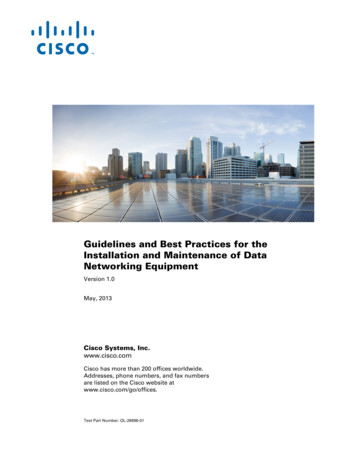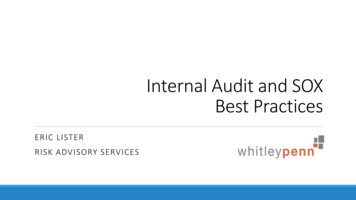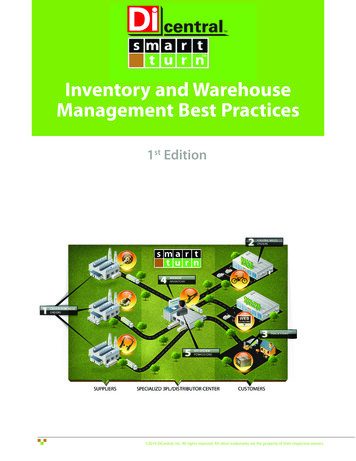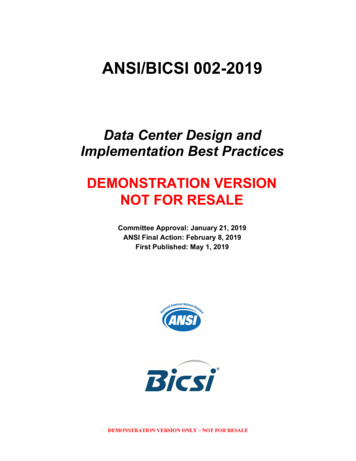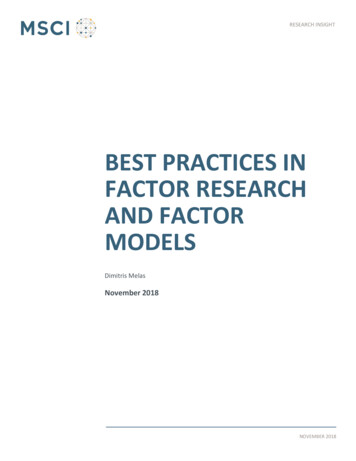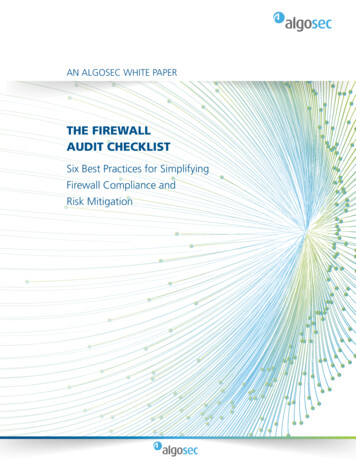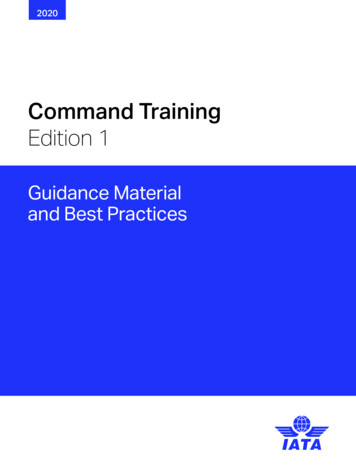
Transcription
2020Command TrainingEdition 1Guidance Materialand Best Practices
NOTICEDISCLAIMER. The information contained in thispublication is subject to constant review in thelight of changing government requirements andregulations. No subscriber or other reader shouldact on the basis of any such information withoutreferring to applicable laws and regulations and/or without taking appropriate professional advice.Although every effort has been made to ensureaccuracy, the International Air Transport Association shall not be held responsible for any loss ordamage caused by errors, omissions, misprintsor misinterpretation of the contents hereof. Furthermore, the International Air Transport Association expressly disclaims any and all liability toany person or entity, whether a purchaser of thispublication or not, in respect of anything doneor omitted, and the consequences of anythingdone or omitted, by any such person or entityin reliance on the contents of this publication. International Air Transport Association. AllRights Reserved. No part of this publication maybe reproduced, recast, reformatted or transmitted in any form by any means, electronic ormechanical, including photocopying, recordingor any information storage and retrieval system, without the prior written permission from:Senior Vice PresidentSafety and Flight OperationsInternational Air Transport Association800 Place VictoriaP.O. Box 113Montreal, QuebecCANADA H4Z 1M1Command TrainingGuidance Material and Best Practices, 1st EditionISBN 978-92-9264-181-8 2020 International Air Transport Association. All rights reserved.Montreal—Geneva
ii1st Edition 2020
Table of ContentsForeword. vAcknowledgement . viPublications. viiiAbbreviations and Acronyms . ixDefinitions related to Command Training . xiiSection 1— Introduction . 11.1Scope of the manual .11.3Competencies .21.21.4The concept .1Threat and Error Management (TEM) .4Section 2— Regulatory Requirements . 6Section 3— The Role of the Commander. 73.13.1.1Common topics in the Operations Manuals .7Duties, responsibilities, accountability and authority of the commander . 73.1.23.1.33.2Leadership .9Decision making and safety . 10Integration of OM topics and CBTA . 10Section 4— Aptitude Testing.13Section 5— Competency-Based Training to Command .155.15.25.2.1Concept . 15Preparing the command training program . 15Special emphasis . 16Section 6— Sample Command Training .186.16.26.2.1Assessment and training plans, training materials. 18Developing ground and flight training. 19Developing training objectives, content and materials . 196.3Assessment plan . 256.5Evaluation of the command training . 266.4Line flying as commander under supervision, line check . 25Section 7— Pilot Development Programs .271st Edition 2020iii
Guidance Material and Best Practices for Command TrainingAppendices.29Appendix 1— Regulations .291.2.3.4.5.ICAO .29ICAO Annex 1 - Personnel Licensing . 29ICAO Annex 6 - Operation of Aircraft . 30EASA .32FAA .34Transport Canada .37Japan Civil Aviation Bureau .42Appendix 2 — Examples of Pilot Development Programs .441.Airline A – mainly recruiting ab-Initio pilots .443.Airline C – recruiting ab-Initio pilots .522.4.Airline B – recruiting direct entry First Officers with experience .45Airline D – recruiting ab-Initio and experienced pilots .53Appendix 3—Competencies.551.2.3.ivICAO COMPETENCY FRAMEWORK TO DEVELOP COMPETENCY-BASED TRAING AND ASSESSMENTFOR AEROPLANE PILOT LICENCES, RATINGS, AND RECURRENT TRAINING .55“Application of Knowledge”, as proposed by EASA for EBT .58Chapter 7: THE ICAO PILOT INSTRUCTOR AND EVALUATOR COMPETENCY FRAMEWORK. 591st Edition 2020
ForewordDear Colleagues,It is our pleasure to introduce the 1st Edition of the Guidance Material and Best Practices for Command Training.This innovative guidance proposes the first Competency-Based Training and Assessment (CBTA) approach for thedesign of pilot development programs with special emphasis on command training.The CBTA approach to command training is a strategic IATA initiative that sustains the IATA Total Systems Approach,which stands for the application of CBTA across all aviation disciplines in general, and to all modules and roles of apilot’s entire career in particular.In 2018, IATA estimated that the number of passengers could double to 8.2 billion by 2038. This forecast is expectedto cause a rapid fleet expansion which, combined with high retirement rates, will certainly expedite the pilot careerpath for first officers to upgrade as a commander.In this context and given the essential contribution of the pilots and commanders to flight safety, it was important tolook into the existing command training curricula and propose solutions to enhance globally the level of competencyof the commanders. Hence, this manual is dedicated to their training, and its content can be used by operators and bytraining organizations.The content of this manual may also be useful for the design of other training programs such as operator conversioncourses, cruise relief pilot training, commander recurrent training, etc.It is our belief that the shared efforts put into the development of this new approach to command training willcontribute to achieving our common goal of improving aviation safety worldwide.We want to acknowledge the valuable work and support provided by the IATA Pilot Training Task Force in thedevelopment of this manual. Without their support the publication of this manual would not have been possible.Best Regards,Gilberto Lopez MeyerVice-President, Safety and Flight OperationsIATA1st Edition 2020v
Guidance Material and Best Practices for Command TrainingAcknowledgementWe want to acknowledge the contribution of the following members and observers of the IATA Pilot Training TaskForce (PTTF), in the development of this manual.Capt. Arnar AgnarssonCapt. Fabien LaignelMSc Human FactorsCrew Training Safety ManagerB767/757 Captain TRESME CRMIcelandairStephane ClementDirector Regulatory AffairsAviation Safety and Quality AssuranceCivil TrainingCAECapt. John CraigDirector, TrainingFlight OperationsAir CanadaCapt. Glen DavisA320 Fleet CaptainFlight Operations TrainingDelta Air LinesCapt. Hartmut FabischIATA Senior ConsultantCapt. Glen FinchIFALPA Human Performance CommitteeLine Training Captain, Jazz AviationCapt. Robert GräfType Rating Instructor/Examiner (TRI/TRE)Flight Operations Support & Training StandardsAirbusCompliance and Regulatory AffairsAir FranceCapt. Mike McCaskyManaging Director Flight TrainingUnited AirlinesCapt. Christian NordenDirector A350 XWB Flight Operations & TrainingSupportAirbusCapt. Joao Carlos Pretto CentenoFlight Standards, Training and Quality ManagerGolCapt. Thomas RobertsonDirector Flight TrainingBoeing Test & EvaluationBoeingCapt. Stefan Thilo SchmidtHead Regulatory AffairsCrew TrainingLufthansa German AirlinesCapt. Kenneth P. ShrumHead of Training-AmericasBoeing Flight ServicesCommercial Aviation ServicesThe Boeing CompanyCapt. Shinya HoshinoCapt. Swee Tiag QuekStrategic Pilot ResourcingFlight Operations Training and StandardsB777 Captain, Vice PresidentFlight Operations PlanningJapan AirlinesviDeputy Chief Pilot – TrainingSingapore Airlines1st Edition 2020
AcknowledgementCapt. (Ret) Yann RenierHead Train
The content of this manual may also be useful for the design of other training programs such as operator conversion courses, cruise relief pilot training, commander recurrent training, etc. It is our belief that the shared efforts put into the development of this new approach to command training will
